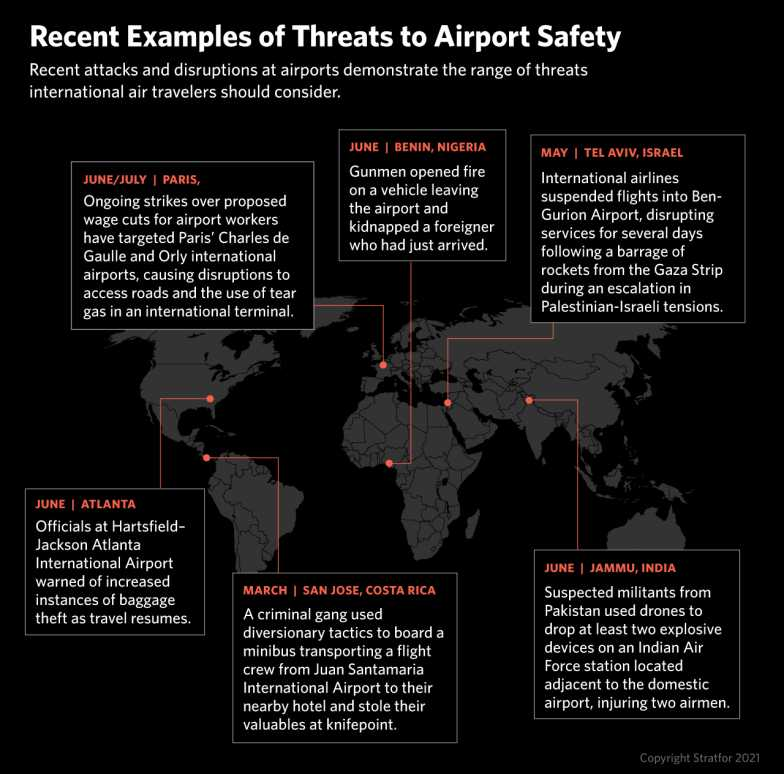International airports are integral hubs of global transportation infrastructure, which has made them targets for a range of extremist, criminal, espionage, protest and cyber threats. For violent extremist groups, airports serve as symbolic and strategic targets to attract attention to their cause and undermine local authorities. Meanwhile, financially motivated criminals are attracted to the affluent demographic that patronizes international airports, which is more likely to be carrying valuables. For their part, protest groups can significantly amplify their grievances by disrupting flights or even grinding operations to a halt. And airports are a chokepoint for international travel, allowing spies unique access to potential espionage targets entering and leaving the country. Finally, cyber threats ranging from criminally motivated opportunistic Wi-Fi monitors to state-backed espionage threats have targeted, and will increasingly target, airports and the airlines that rely on them.
Extremist and Militant Threats
Enhanced security measures, focused intelligence collection efforts and an overall weakened transnational jihadist movement have contributed to a decline in successful terrorist attacks against aircraft over the past decade. The less secure landsides of airport terminals, however, remain vulnerable. Planes have been targets for hijackers and attackers since the introduction of commercial air travel in the early 20th century and they are still attractive targets. The attacks of Sept. 11, 2001, represent the apex of the aviation threat, but security measures introduced since have greatly reduced the threat of future attacks on aircraft. While threats still exist, they are becoming rarer. The last successful terrorist attack that caused mass fatalities on a passenger aircraft was the October 2015 bombing of Metrojet Flight 9268, when Islamic State followers in Egypt's Sinai Peninsula claimed responsibility for an explosion that caused the aircraft to crash shortly after departing Sharm el-Sheikh, killing all 224 passengers and crew. In 2016, al-Shabaab claimed responsibility for deploying a suicide bomber who successfully smuggled and detonated an explosive device onboard Daallo Airlines Flight 159 shortly after leaving Mogadishu, Somalia, but the aircraft was able to safely return to the airport, with the only reported fatality being the suicide bomber.
More recent plots demonstrate the persistent interest in targeting aircraft, but highlight how security measures have greatly mitigated the threat. Most recently, in June 2021 crew aboard Delta Airlines Flight 386 bound for Nashville from Los Angeles subdued an unruly passenger who was attempting to breach the cockpit door, forcing the pilots to divert the plane to Albuquerque, New Mexico. While the suspect's specific motive remains unclear, at the time crew had to treat the incident as an attempted hijacking. Hardened cockpit doors and training for crew members adopted post-9/11 still demonstrate how aircraft are much harder targets today than 20 years ago.
Increased intelligence collection has also disrupted plots in the planning stage. In July 2019, authorities in the Philippines arrested Kenyan national Cholo Abdi Abdullah and eventually transferred him to U.S. custody on charges of plotting an al-Shabaab-backed, 9/11-style attack involving crashing airplanes into buildings. While in this case, the disruption became public knowledge, increased intelligence collection and security cooperation between the United States and countries around the world (in this case the Philippines and Kenya) presumably have helped to identify many other never-reported plots well before they pose a threat to the public.
The hardening of security around air travel has generally pushed the threat outward toward softer targets associated with air travel. Separate groups of Islamic State-backed extremists in 2016 highlighted the vulnerabilities of the landside of airport terminals by attacking check-in lines in Istanbul and Brussels, killing 45 and 14 people, respectively, (attacks elsewhere in Brussels killed an additional 18 people) and causing weeks of disruptions. While terrorists are less likely to be able to smuggle an explosive device onto or hijack an aircraft leaving from a relatively secure facility, they can still target the softer, landside of the airport outside the hardened security perimeter.
Finally, militants in ongoing conflicts often target airports and air travel directly or indirectly, causing disruptions and occasionally fatalities. National security forces often co-occupy space at civilian airports to share air traffic infrastructure, making them higher profile targets even for militant groups seeking to avoid civilian casualties. Militants in conflict zones often have the advantage of controlling territory from which they can launch indirect rocket fire or even explosive-laden drones, posing a sustained threat to air travel and other civilian targets. Anyone traveling to or through conflict areas should be aware of the persistent threats to air travel and prepare for associated disruptions, if not reconsider travel altogether.
July 2021: Militants used drones to attack Arbil International Airport in Iraq; no injuries were reported.
June 2021: Suspected militants from Pakistan used drones to drop at least two explosive devices on an Indian Air Force station located adjacent to Jammu airport, injuring two airmen.
May 2021: International airlines temporarily suspended flights into Tel Aviv's Ben-Gurion Airport following a barrage of rockets from the Gaza Strip during an escalation in Israeli-Palestinian tensions.
Criminal Threats
Airports and specifically passenger terminals are notorious spots for both opportunistic and targeted criminal activity that is less consequential than violent extremist and militant attacks, but far more likely to impact the regular traveler. The exhaustion and disorientation that come after a long international flight to a foreign country, combined with the fact that international travelers are often wealthier than the average local resident (and likely carrying valuables), make airports prime hunting grounds for criminals. Criminals know just as well as legitimate merchants and advertisers that international air travelers are relatively well off and in need of help in a new place. Pick-pockets, baggage thieves, fake taxis and a multitude of other scammers and hustlers base themselves at airports to target distracted (and often wealthier) travelers. More sophisticated criminals often identify targets at the airport and intercept them during their transfer into town, or on their way to the airport.
July 2021: Armed robbers stole $10,000 and 21 cellphones and other valuables from humanitarian workers on their way to an airport in northern South Sudan.
June 2021: Officials at Hartsfield-Jackson Atlanta International Airport warned of increased instances of baggage theft targeting unattended luggage in arrival terminals as post-pandemic travel resumes.
June 2021: An armed kidnapping gang opened fire on a vehicle leaving the Benin, Nigeria, airport and abducted a foreigner who had just arrived. The gang shot and killed three members of the foreigner's security detail.
March 2021: A criminal gang used diversionary tactics to board a minibus and steal valuables at knifepoint from American Airlines flight crew members who had recently arrived at the international airport in San Juan, Costa Rica.
July 2019: Armed professional thieves stole $40 million worth of gold and precious metals from the cargo terminal at Sao Paulo/Guarulhos International Airport in Brazil.
As demonstrated in the incidents above, criminal activity ranges from the simple and opportunistic to the sophisticated and carefully planned. Departure and arrival areas on the landside of the airport are open to the public and provide excellent cover for opportunistic thieves to walk through crowds, selecting easy targets for theft, all the while pretending to be waiting for a departing or arriving loved one. Criminal threats extend out to parking areas, where thousands of vehicles can sit unattended for days with minimal supervision. In higher level crime areas, more sophisticated organized criminal groups exploit the more permissive environment by targeting vehicle traffic to or from the airport. Most criminal activity is nonviolent and systemic, taking advantage of targets who simply do not know better or who are unprepared. A criminal gang working at Rio de Janeiro/Galeao International Airport operated a yearslong scam diverting arriving visitors to unauthorized taxicabs, where at best, passengers faced inflated rates, and occasionally faced extortion and theft.
Cybercriminal activity also is of increasing concern to air travelers and is a threat that does not necessarily stop at the security screening checkpoint. Numerous security researchers have repeatedly highlighted the risk of connecting to public Wi-Fi ports, including in airports. In some cases, hostile actors can establish unauthorized Wi-Fi points to attract users and intercept their information. But even authorized airport Wi-Fi services are unsecured and anyone with easily accessible software or apps can monitor network activity to see who is online and what they are doing. More advanced software packages could allow hostile actors to intercept login credentials, credit card information or other sensitive details. This threat applies to both the landside of the airport, where virtually anyone can easily snoop on internet traffic, and the more secure airside of the airport. Bringing cyberweapons such as malware packages, spyware or even ransomware into an airport terminal is much easier than bringing physical weapons like knives, firearms and explosive devices.
The insecurity of Wi-Fi networks at airports and the potential value of the information shared over such networks also makes them attractive to state-backed intelligence collection efforts. In 2014, some of the leaked information on intelligence capabilities that came from NSA contractor Edward Snowden indicated that Canada's electronic surveillance measures included tracking free Wi-Fi networks at Toronto Pearson International Airport. State-backed security and intelligence services can monitor Wi-Fi traffic remotely; they do not necessarily need a physical presence in the terminal.

How to get your free month
How pricing works
How to view posts
What you can post
A #podcast about #persuasion, #deception, #communication, and the #Grayman
https://promocards.byspotify.com/share/5e3dfefd944d823be992a43447470e279711b635
These are some of my favorite camping tips A #podcast about #preparedness, #camping, #hiking, and the #Grayman
https://spotifyanchor-web.app.link/e/umedj5kJiBb














